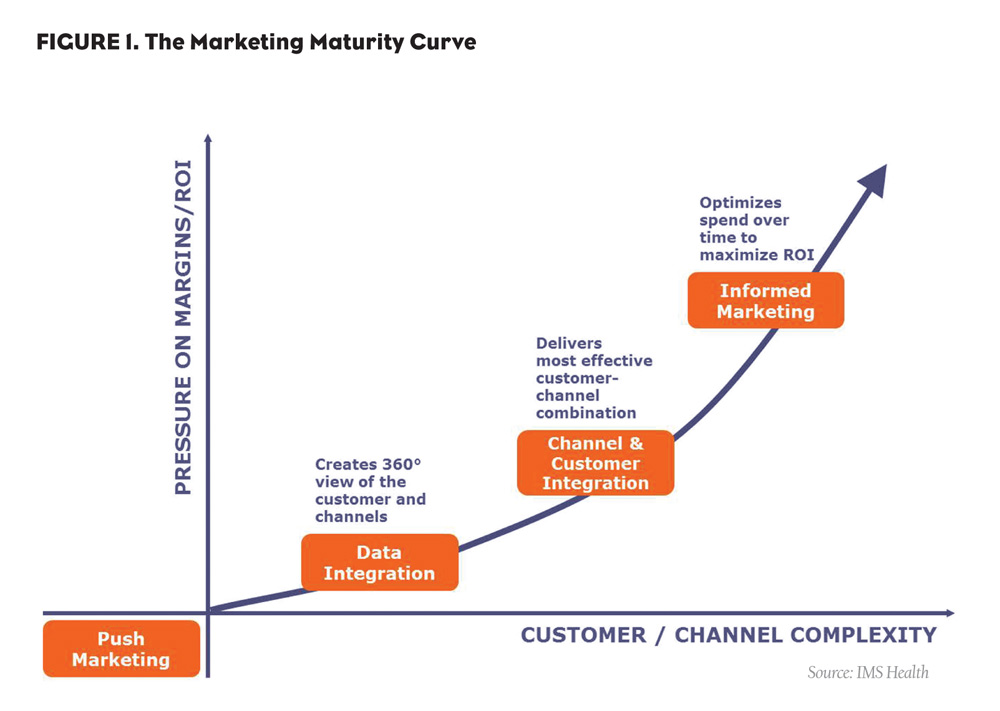As life sciences companies look to differentiate themselves in an increasingly competitive market, a new technology landscape is emerging. Brand teams are voicing new requirements based on their vision of what “good” marketing looks like today. Technology must enable the execution of marketing campaigns that deliver optimal messaging to a wide array of healthcare stakeholders across several communication channels. Yet even as marketers try to move past traditional barriers to marketing success—long cycle times, monolithic campaign designs and loosely federated tactics—fundamental gaps persist in the enablement of marketing technology capabilities.
Other industries that have historically used more advanced marketing techniques than the life sciences industry still clamor for more robust marketing technology to support their evolving needs.
New technology gives today’s life sciences marketers an unprecedented opportunity to nurture deep customer relationships. The key to success involves flipping the traditional model by focusing on optimization and taking action.
What challenges do today’s healthcare marketers face?
In today’s life sciences marketing industry, marketers face a variety of factors that complicate their jobs. First, there is the shift from marketing to one customer type—the physician—to many different customer types. The declining access of sales reps to high-value healthcare professionals (HCPs), along with the fact that doctors no longer have complete control over prescribing decisions, means that marketers must influence many different healthcare stakeholders—including payers, Integrated Delivery Networks (IDNs), patients and caregivers. Second, there is a shift from a few channels—for example, sales force, direct mail and journal ads—to a wide variety of channels. While these traditional channels may continue to be relevant, they now must work in concert with other digital and non-personal channels such as email, mobile, online advertising, health forums, social media and branded and unbranded websites. The result is an intricate web of customers and channels, all of which influence one another.
Because of this interconnectedness, brands must start with a clear strategy for understanding the various healthcare stakeholders and prioritizing which groups should be targeted. They must then use the right channels to reach these groups with the right messages. At the same time, marketers must ensure that prioritization decisions result in maximum return on investment (ROI).
What are the priorities of healthcare stakeholders?
Step into the shoes of a physician, caregiver or patient for a moment. What does each of these groups want? Generally, they want useful, relevant information that will help them make informed healthcare decisions. In an ideal world, when patients face these questions, they would visit their doctors. But in reality, before and after their doctor visit most patients will turn to friends, support groups, online health forums and branded websites. The ultimate treatment path these patients follow may be influenced by any of these information sources.
The concept of providing “the right information at the right time” also implies there is some information that customers may not want to receive. Messages that might resonate for one segment of patients at a particular time could be the wrong messages for another segment, even though the two segments may share the same condition and treatment stage. Additionally, the appropriateness of various channels will vary in each situation, because patients want to receive information in their channel of choice. Orchestrating the customer experience effectively helps companies move up the Marketing Maturity Curve to achieve the ultimate goal of Informed Marketing (see Figure 1).
Key Components of Marketing Success
Building meaningful customer relationships depends on four key factors and requirements, regardless of the group being targeted:
1. A deep understanding of the customer. This involves having a full 360 view of each customer’s profile, touch points, responses and behaviors, and it can be achieved by integrating the customer profile with all sales and marketing activities into one database.
2. Identifying optimal messages for each audience. Achieving this requires a segmentation strategy, as well as executing message testing against subsets of market segments, which can drive greater impact.
3. Seamless orchestration of campaigns across channels. A healthcare-specific marketing platform should be leveraged to automate campaign execution across channels.
4. Ready access to data and rapid conversion into actionable insights and optimization. Marketers should have immediate feedback on the success of tactics and campaigns, and have a process in place to make changes to campaigns while “in flight” if something isn’t working.
Future State Vision: The Shift to Relationship Marketing
Brands can start to push past the barriers to relationship marketing success by taking an inventory of current capabilities and practices. Brand teams should assess whether or not their current technology and service providers meet the needs of the new healthcare promotional model. The right technology can be both an enabler and an agent of change, accelerating critical decisions that need to be made in order to propel marketing approaches to the next level.
Life sciences marketers recognize the need to change and have started to embrace it by sponsoring innovative technology within their organizations that:
- Combines all relevant customer data and uses it as the foundation for campaigns.
- Uses fully automated campaign planning and execution technology to easily coordinate activity across all channels.
- Executes consistently branded campaigns across all channels.
- Measures ROI of tactics and campaigns.
- Optimizes customer experience on the basis of prior customer response.
- Allocates future marketing spend on the basis of tactic and campaign ROI analysis.
- Shares marketing insights via online dashboards and reports.
- Enables enhanced customer experience and true relationship marketing.
Advances in the technology of gathering and relating data in an actionable way can radically change the way life sciences marketers approach customer relationships. Marketers who embrace this new technology have an opportunity to move from simply integrating data to taking action with their data and optimizing their marketing efforts.








